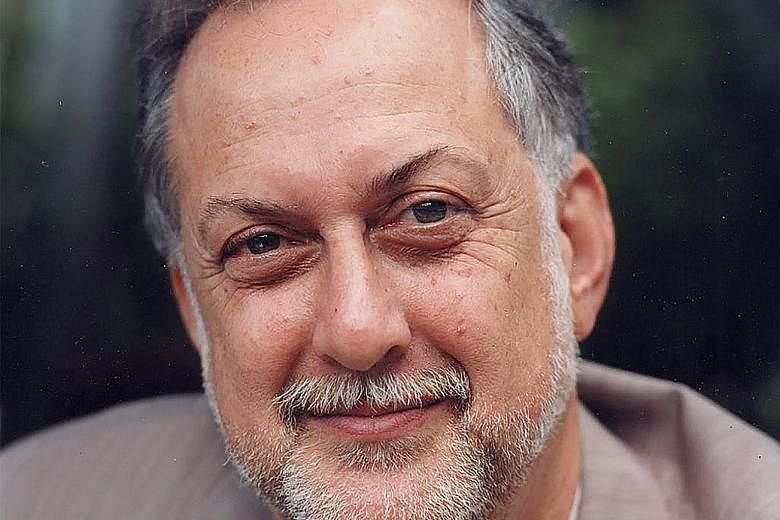NEW YORK • Mr Michael Sorkin, an influential architecture critic, author, designer and urban visionary, died last Thursday in Manhattan. He was 71.
His wife and only immediate survivor, Dr Joan Copjec, said the cause was the coronavirus.
Mr Sorkin was architecture's most outspoken public intellectual, a polymath whose prodigious output of essays, lectures and designs - all promoting social justice - established him as the political conscience in the field.
In lectures and in years of teaching, he inspired audiences and students to use architecture to change lives, resist the status quo and work towards achieving social equity. His motivational writing and projects helped reset the field's moral compass.
With degrees from the University of Chicago and Columbia University, and a master's in architecture from the Massachusetts Institute of Technology, he moved in 1973 from Cambridge to New York, a city he said he adored for its opera and toasted bagels. It remained his home for the rest of his life.
He and his wife, a professor of film theory at Brown University, spent decades in a modest apartment in Greenwich Village, from which he commuted daily on foot to his studio in Tribeca.
He based one of his dozen books, Twenty Minutes In Manhattan (2009), on his pedestrian odyssey.
His writing ranged in scope from urban theory to the Israeli border wall to issues of sustainability.
He specialised in compressing biting wit and intellectual scope in irresistible sentences that buoyed serious arguments.
His designs, mostly unbuilt statements of theory, were equally wide-ranging: a small-lot apartment competition in New York, a masterplan for a Palestinian capital in East Jerusalem, vast urban planning schemes for competitions in China.
He laced his urban proposals with green zones and designed lighthearted zoomorphic buildings, such as a seaside hotel shaped like a jellyfish drifting in the current.
A natural radical who saw architecture through a political and social lens, Mr Sorkin maintained an outsider's critical perspective even as he entered the establishment as head of his own architecture firm and as director of the graduate urban design programme at the City College of New York.
His practice, writing and academic position gave him a platform.
At the beginning of his career, he made his reputation by speaking truth to power. When he achieved a degree of power, he continued to speak truth, as though still an outsider.
Mr Sorkin established himself as a public figure from 1980 to 1990 at weekly newspaper The Village Voice, where he wrote searing critiques, leavened with humour, that were often delivered at the expense of people who lived uptown.
"He said what everyone was really thinking, but was afraid to say," said art dealer Max Protetch, whose Max Protetch Gallery specialised in architects' drawings.
Mr Philip Johnson, long ensconced as the dean of American architecture by the time Mr Sorkin began writing, was a conspicuous target.
Mr Sorkin ripped into Mr Johnson's post-Modernist AT&T Building on Madison Avenue (1984), designed like a Chippendale highboy, calling it a tarted-up "Seagram Building with ears". In the humour magazine Spy, he outed Mr Johnson as a former Nazi sympathiser, a fact no one at the time dared whisper.
"I thought of Michael as a bomb thrower because his pieces always shook things up," said Ms Cathleen McGuigan, editor-in-chief of Architectural Record magazine, where Mr Sorkin was a long-time contributing editor.
Mr Sorkin was an activist critic with a social agenda. He started his career identifying abuses of power while facing the headwinds of the conservative Ronald Reagan era. "Politics programmes our architecture," he wrote.
He advocated for housing and green energy rather than prisons and malls, and for citizens to participate in the design of their own urban destinies.
He believed the city, as architecture's largest expression, shaped how people led their lives, behaved and thought. He viewed urban design as an instrument of enlightened social engineering, political justice and power sharing. He inveighed against the privatisation of public space.
Mr James Wines, founder of Site, a New York-based environmental arts firm, said: "Ultimately, Michael was a humanist: He believed in building for people, not the power structure. Within the scope of his broad theories, he focused on how people use street signs, roadways and infrastructure. He was a complex thinker and he designed complexity."
As part of a theoretical project for redesigning the East New York section of Brooklyn, Mr Sorkin proposed planting trees in an intersection to reduce public space devoted to traffic and encourage the growth of a more agrarian, low-density neighbourhood.
Mr Andrei Vovk, Mr Sorkin's architectural partner from 1992 to 2001, said: "Michael wasn't doing urban planning. He initiated organic patterns."
China's explosive growth over the past 20 years gave Mr Sorkin the opportunity to actually build his imaginary cities. Many of his vast urban designs for China placed among the winners of competitions. None were built, although Mr Vovk said their ideas were adapted by other projects.
Mr Sorkin was born in Washington on Aug 2, 1948, to George and Ruth Sorkin. His father was a scientist, his mother a housewife. He attributed the beginnings of his interest in architecture to the fact that the family's home was in an architect-designed community.
NYTIMES

